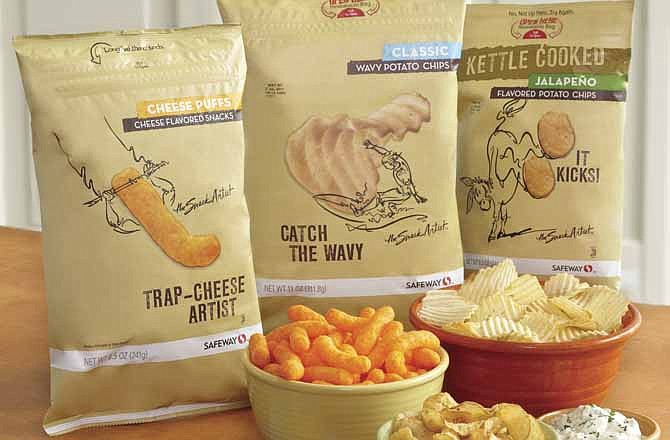Supermarkets including Kroger, Safeway and Whole Foods are improving the image of their store brands with better packaging and more distinctive offerings. But where exactly do these products come from?
It's a question a growing number of people may have as retailers increasingly develop their store brands as a way to cultivate loyalty among shoppers.
Safeway, for example, offers versions of Doritos, Cheetos and other salty snacks. But rather than merely imitating the look of their big-name counterparts, the "Snack Artist" line comes in distinctive, earth-tone bags made to look more like a premium brand. The Safeway logo appears only a small strip at the bottom.
"In many cases, people are buying some of our brands and think it's a national brand," said Diane Dietz, chief marketing officer for Safeway.
The rise of store brands - known in the industry as "private-label" products - became apparent last year when ConAgra Foods Inc. said it was buying Ralcorp Holdings Inc. Although it's not a household name, Ralcorp makes pasta, granola bars and other foods for a wide array of retailers.
ConAgra executives note that there's still plenty of room for growth, with store brands representing just 18 percent of packaged foods in the U.S., compared with 36 percent in the United Kingdom and 44 percent in the Netherlands.
So as store brands get more attention, here's a look at what's behind the packaging.
WHO MAKES THEM?
To maintain the image of their store brands, supermarkets like to keep the origins a mystery.
One reason Whole Foods doesn't reveal the suppliers for its in-house "365 Everyday Value" products is that it may be carrying other branded products made by the same companies, said Brianna Blanton, who manages store brands for the organic grocer.
For a shopper, tracking down which company made a particular product can also be challenging because the store-brand industry is fragmented.
Supermarkets often work with a network hundreds of suppliers to produce their store brands. These include national name-brand companies that make store brands on the side as well as businesses that specialize in making store brands.
The store-brand specialists often focus on certain product categories as well, said Mike Minasi, Safeway's president of advertising and marketing. Overhill Farms, a company based in Vernon, Calif., for example, is known for making frozen foods, he said.
And not all store brands are made by outside companies. Kroger, for instance, has 37 plants that churn out about 40 percent of its store brands. Safeway also makes some of its own brands.
ARE THEY REALLY ANY DIFFERENT?
Everyone knows store brands are usually cheaper. But they have also grown because they offer something new, or make an improvement on better-known products.
One way Whole Foods differentiates its "365 Everyday Value" products is by examining nutritional stats. In many cases, a registered dietitian on staff works with the grocer's suppliers to see if there are ways to lower sodium or fat content.
Stores are pushing to offer more distinctive products. So the process for developing new store-brand items has gotten more sophisticated and mirrors how name-brand products are conceived and marketed, said Jesse Spungin, general manager for ConAgra's store brands business.
Nevertheless, people may wonder how unique some store-brand products can be when they're made in factories that churn out other store-brand or name-brand products. Sometimes, the difference is really just cosmetic.
To ensure efficiency in production lines, for instance, ConAgra CEO Gary Rodkin says the company pushes "differentiation as far downstream as possible." For some product lines, he said there are no changes made until the very end, when a different seasoning or packaging is applied.
Pantry staples such as saltines are less likely to have significant differences as well, because people expect certain qualities for such products. There's also less room for variation with products that only have a few ingredients.
"There aren't a lot of changes you can make to a can of low sodium black beans," said Blanton of Whole Foods.

